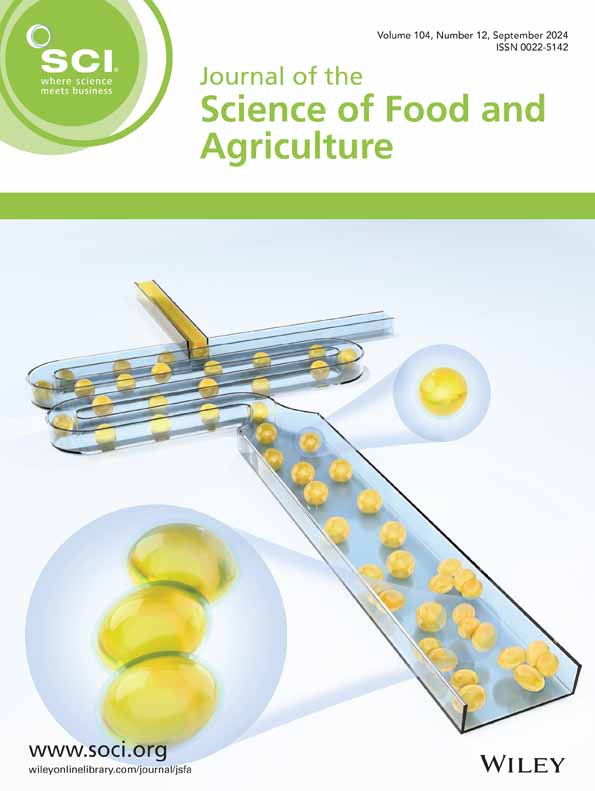Fataneh Hashempour-Baltork, Adel Mirza Alizadeh, Sarah Ghasemi, Kosar Gerami, Saeid Vahedi, Samira Mardanian-Jaghanab, Hedayat Hosseini, Naim Montazeri, Hassan Hassanzadazar, Hossein Rastegar
求助PDF
{"title":"A global systematic review and meta-analysis of virus prevalence in vegetables and fruits: meta-regression approaches of climatology and food security index effects.","authors":"Fataneh Hashempour-Baltork, Adel Mirza Alizadeh, Sarah Ghasemi, Kosar Gerami, Saeid Vahedi, Samira Mardanian-Jaghanab, Hedayat Hosseini, Naim Montazeri, Hassan Hassanzadazar, Hossein Rastegar","doi":"10.1002/jsfa.14330","DOIUrl":null,"url":null,"abstract":"<p><p>This systematic review and meta-analysis was conducted to investigate the spread of viral contamination (hepatitis A, human norovirus, astrovirus and adenovirus) in vegetables and fruits. The most frequent types of vegetables involved were chicory (73%), silver beet (50%), watercress (34%), leek (30%) and purslane (21%). Vegetables exhibited a higher pooled prevalence of viral contamination (2%; 95% confidence interval = 1-3%) than fruits (no prevalence was observed). High levels of virus prevalence in vegetables were recorded in Argentina (35%), Egypt (23%) and Belgium (23%), whereas, for fruits, the most contaminated products were related to products from Egypt (20%). The most common viral contaminations in products were human astrovirus (29%) and human adenovirus (26%) for vegetables and porcine adenovirus (2%) for fruits. Fresh vegetables (2%) and frozen fruits (4%) had higher reports of viral prevalence than frozen vegetables and fresh fruits. In addition, frozen vegetables and fresh fruits were not reported for viral contamination. Our findings showed that the prevalence of virus prevalence has a direct relationship with climatological parameters, and regardless of Egypt (total 25.52% contamination), areas with humidity above the range of 65-70%, average temperature of 10-15 °C and annual rainfall of approximately 1000 mm, the prevalence showed higher viral contamination (P < 0.05). Moreover, the results show that countries with a low Global Food Security Index had high infection rates (P < 0.05). Governments should ensure that, through risk management protocols, the possibility of zoonotic infection transmission in fruits and vegetables is continuously monitored and controlled to reduce the risk of contamination. © 2025 Society of Chemical Industry.</p>","PeriodicalId":17725,"journal":{"name":"Journal of the Science of Food and Agriculture","volume":" ","pages":""},"PeriodicalIF":3.3000,"publicationDate":"2025-05-07","publicationTypes":"Journal Article","fieldsOfStudy":null,"isOpenAccess":false,"openAccessPdf":"","citationCount":"0","resultStr":null,"platform":"Semanticscholar","paperid":null,"PeriodicalName":"Journal of the Science of Food and Agriculture","FirstCategoryId":"97","ListUrlMain":"https://doi.org/10.1002/jsfa.14330","RegionNum":2,"RegionCategory":"农林科学","ArticlePicture":[],"TitleCN":null,"AbstractTextCN":null,"PMCID":null,"EPubDate":"","PubModel":"","JCR":"Q1","JCRName":"AGRICULTURE, MULTIDISCIPLINARY","Score":null,"Total":0}
引用次数: 0
引用
批量引用
Abstract
This systematic review and meta-analysis was conducted to investigate the spread of viral contamination (hepatitis A, human norovirus, astrovirus and adenovirus) in vegetables and fruits. The most frequent types of vegetables involved were chicory (73%), silver beet (50%), watercress (34%), leek (30%) and purslane (21%). Vegetables exhibited a higher pooled prevalence of viral contamination (2%; 95% confidence interval = 1-3%) than fruits (no prevalence was observed). High levels of virus prevalence in vegetables were recorded in Argentina (35%), Egypt (23%) and Belgium (23%), whereas, for fruits, the most contaminated products were related to products from Egypt (20%). The most common viral contaminations in products were human astrovirus (29%) and human adenovirus (26%) for vegetables and porcine adenovirus (2%) for fruits. Fresh vegetables (2%) and frozen fruits (4%) had higher reports of viral prevalence than frozen vegetables and fresh fruits. In addition, frozen vegetables and fresh fruits were not reported for viral contamination. Our findings showed that the prevalence of virus prevalence has a direct relationship with climatological parameters, and regardless of Egypt (total 25.52% contamination), areas with humidity above the range of 65-70%, average temperature of 10-15 °C and annual rainfall of approximately 1000 mm, the prevalence showed higher viral contamination (P < 0.05). Moreover, the results show that countries with a low Global Food Security Index had high infection rates (P < 0.05). Governments should ensure that, through risk management protocols, the possibility of zoonotic infection transmission in fruits and vegetables is continuously monitored and controlled to reduce the risk of contamination. © 2025 Society of Chemical Industry.
蔬菜和水果病毒流行的全球系统回顾和荟萃分析:气候学和粮食安全指数效应的荟萃回归方法。
本系统综述和荟萃分析旨在调查病毒污染(甲型肝炎病毒、人诺如病毒、星状病毒和腺病毒)在蔬菜和水果中的传播。最常见的蔬菜类型是菊苣(73%)、银甜菜(50%)、豆瓣菜(34%)、韭菜(30%)和马齿苋(21%)。蔬菜显示出较高的病毒污染总流行率(2%;95%可信区间= 1-3%)高于水果(未观察到患病率)。阿根廷(35%)、埃及(23%)和比利时(23%)的蔬菜病毒流行率很高,而水果中受污染最严重的产品是来自埃及的产品(20%)。产品中最常见的病毒污染是蔬菜中的人类星状病毒(29%)和人类腺病毒(26%),水果中的猪腺病毒(2%)。新鲜蔬菜(2%)和冷冻水果(4%)的病毒感染率高于冷冻蔬菜和新鲜水果。此外,冷冻蔬菜和新鲜水果没有病毒污染的报告。研究结果表明,病毒流行率与气候参数有直接关系,无论埃及(总污染率为25.52%)、湿度在65-70%以上、平均温度在10-15℃、年降雨量在1000 mm左右的地区,病毒流行率都表现出较高的病毒污染率(P
本文章由计算机程序翻译,如有差异,请以英文原文为准。

 求助内容:
求助内容: 应助结果提醒方式:
应助结果提醒方式:


